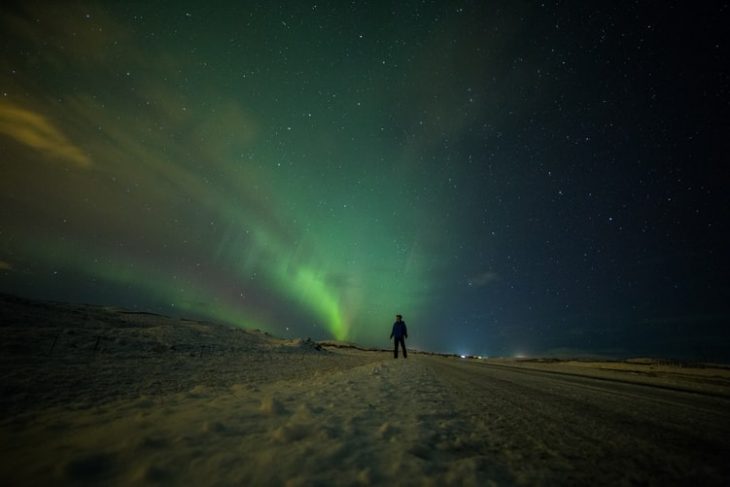
There is more to a spectacular light show than the aesthetics that it presents in a photograph. Did you know what makes the Northern Lights and when, specifically, it comes to display? Those are just a few of the interesting northern lights facts that you are about to learn from this article. Add some fun knowledge to that magnificent visual!
- The Aurora lights are nature’s very own majestic light show.
- Gaseous particles’ collision with charged particles results in the said natural phenomenon.
- The type of clashing gas particles yields color variations.
- They could also be called ‘polar lights’ due to their relation to polar regions.
- Early documentations of the Aurora Borealis trail back to 30,000 years ago in a French cave.
- People could see the Northern Lights in places surrounding both the magnetic poles of north and south hemispheres.
- Northern hemisphere auroras are called either ‘northern lights’ or ‘Aurora Borealis.’
- On the other hand, the southern hemisphere auroras are called either ‘southern lights’ or ‘Aurora Australis.’
- Interaction between the high energy particles and the atmosphere causes color changes.
- NASA transmits updates about the light shows telling the best spots to catch the experience or the closest estimated timing.
- The farther north you go, the better your experience would be with the northern lights.
- While it could be difficult to see the lights from April to August, it could still be possible with the help of scientific equipment.
- The Northern Lights could take the forms of light patches, streamers, curtains, arcs, shooting rays and scattered floating clouds.
- The Northern Lights have the same altitude as that of the International Space Station, making it possible for astronomers to view the lights by the side.
- They are visible from space where satellites could take pictures of the lights and spectators from another planet could catch it.
- NASA explained that the entry of solar particles into the magnetic field of the earth causes the visual display of the Northern Lights.
- Despite being associated with wintertime, the Northern Lights could be seen all year round.
- Oxygen molecules from 60 miles above the earth produce the most common color of aurora – green.
- Molecules in higher altitudes of about 200 miles give displays of the rarer color – red.
- Meanwhile, the blue or purple color of the lights is a product of nitrogen.
Northern Lights Facts Infographics
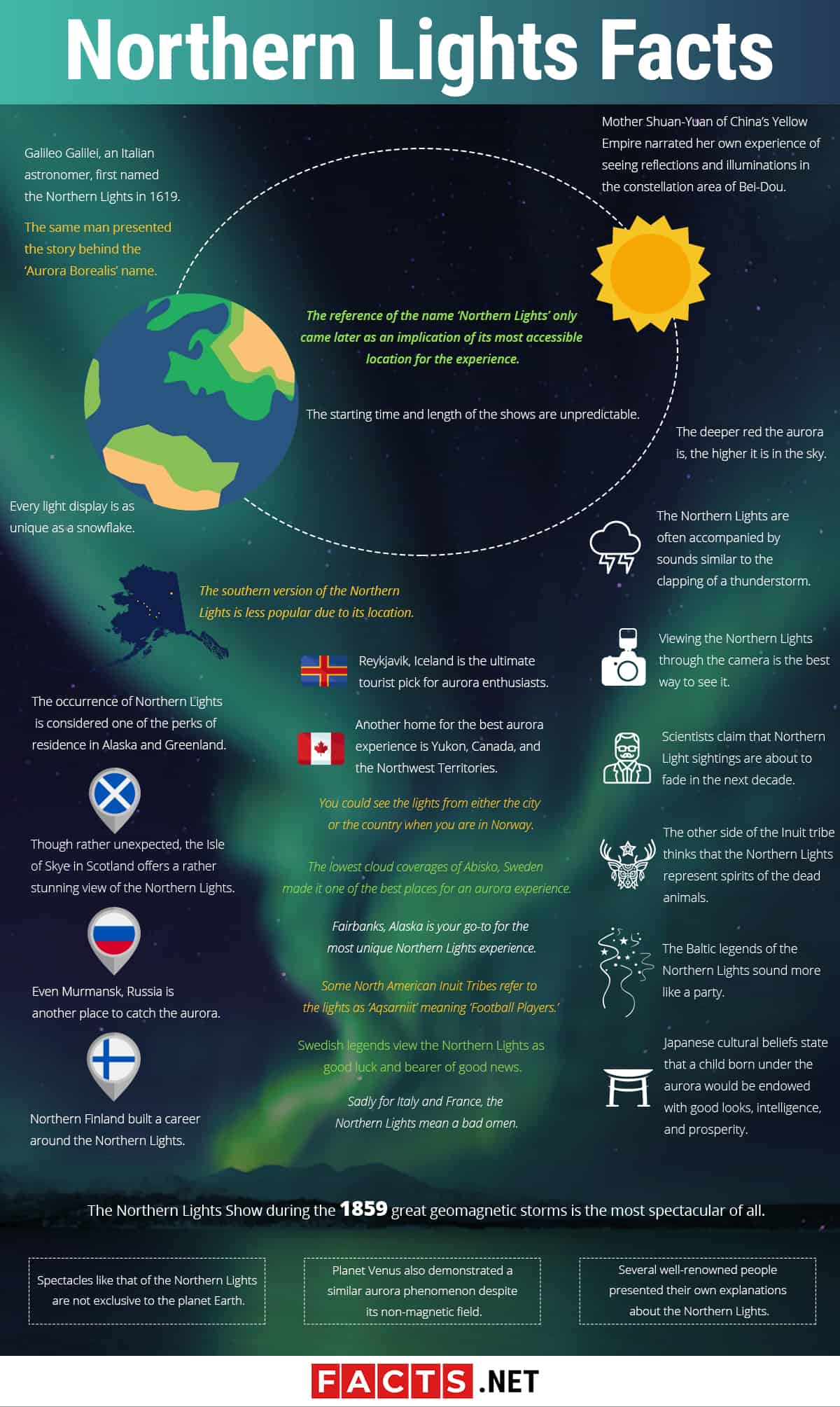
Galileo Galilei, an Italian astronomer, first named the Northern Lights in 1619.
He was the first person to describe the phenomenon into a document. Pairing the terms ‘Aurora’ and ‘Borealis,’ Galilei defined how he saw the aurora as a reflection of sunlight in the atmosphere.
The same man presented the story behind the ‘Aurora Borealis’ name.
Since Galilei believed that the lights were sunlight upon seeing it light up the sky, he thought of Aurora, the goddess of the morning. Borealis is the Greek word for North and pertains to the best location to view the lights.
Mother Shuan-Yuan of China’s Yellow Empire narrated her own experience of seeing reflections and illuminations in the constellation area of Bei-Dou.
Earlier recognition of the Northern Lights was recorded in China in 2600 B.C.
The reference of the name ‘Northern Lights’ only came later as an implication of its most accessible location for the experience.
The greener the color of the aurora appears, the closer it is to you. They would seem as green as possible most of the time as well due to the fact that your eyes are not capable of handling the sight of the colors’ strong varieties.
The deeper red the aurora is, the higher it is in the sky.
It would mean that the solar particles present in the oxygen are at higher levels than normal, and it could be as far away as 400 miles.
Every light display is as unique as a snowflake.
The North Pole has a pull on the colliding particles, hence the interaction with the atmosphere. Upon the release of energy comes the lights show.
Variables such as gases, speed, and interaction cause the diversity which differs every single time.
The Northern Lights are often accompanied by sounds similar to the clapping of a thunderstorm.
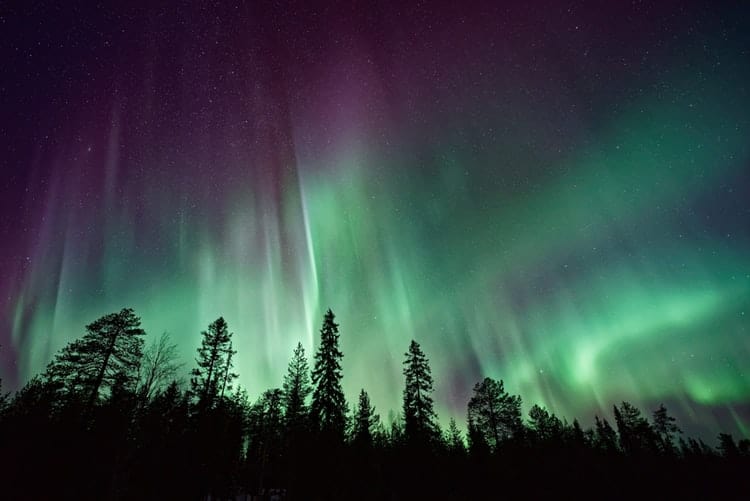
Some nights, there is more than just the visual display. Maximum aurora activity also produces crackling and clapping sounds that could be heard for miles.
The audio factor is the result of the projection of charged particles from the Sun followed by interaction with the magnetic field of the Earth.
The occurrence of Northern Lights is considered one of the perks of residence in Alaska and Greenland.
As it turns out, bearing with the eternal cold is not that bad after all if it means you could see the aurora phenomenon any time of the year. Both locations are so close to the Northern Hemisphere that they are known for being the best locations for viewing.
The southern version of the Northern Lights is less popular due to its location.
The Southern Lights or ‘Aurora Australis’ exists on the opposite side of the famous lights show. Aside from the inaccessibility of the location, it also has limited researchers and abundant wildlife.
Only a few explorers and researchers attempt to trek unsafe land for the southern lights given its twin north version.
Viewing the Northern Lights through the camera is the best way to see it.
Sadly, the human eye falls short in the capacity to see the spectacle to the fullest. Aside from the eye’s sensitivity for certain colors, the speed of the aurora’s movement is also a factor.
That is why it is highly advisable to use a camera with a quick shutter speed as it could help you identify more colors and appreciate the sight even more.
The starting time and length of the shows are unpredictable.
You would need a lot of patience if you really want to catch the Northern Lights. The average visibility time is from 4 pm – 6 am every night, while the hours between 10 pm and 1 am are considered the best times to wait.
Moreover, the magnitude of the incoming solar wind influences the length of a show.
Scientists claim that Northern Light sightings are about to fade in the next decade.
The occurrence of the phenomenon becomes more frequent and sensational when the solar sunspot activity is high. However, its cycle only lasts about 11 years.
While the Northern Lights would expectedly appear less often for the next decade, it would not fully disappear.
Though rather unexpected, the Isle of Skye in Scotland offers a rather stunning view of the Northern Lights.
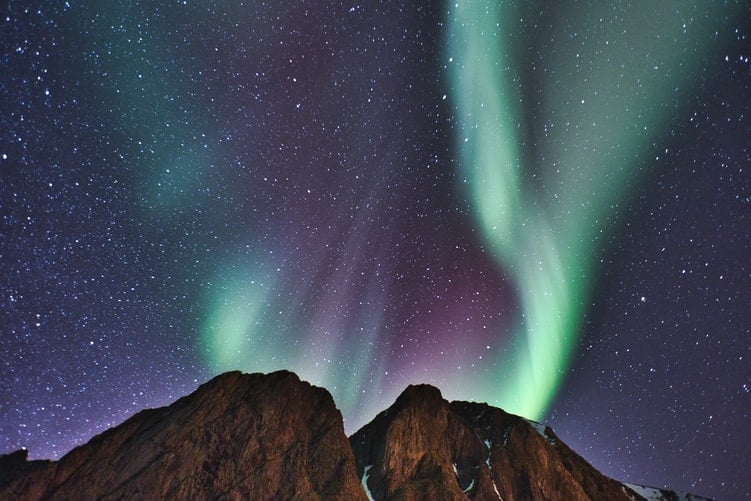
The clear and pollution-free skies of the serene city make Scotland a great place to go stargazing. While the place is not on the list of top places for aurora viewing, it has a calming climate over a wide-opened area that makes it impossible to miss the lights show from the said country.
Even Murmansk, Russia is another place to catch the aurora.
The largest city ahead of the Arctic Circle has better weather compared to Alaska and Sweden. So if you are not that much of a fan of the cold, then viewing the Northern Lights from this city would be the wiser choice.
Reykjavik, Iceland is the ultimate tourist pick for aurora enthusiasts.
The Northern Lights were mainly what made the country popular among the tourists. Most of the tour companies from the place offer another free trip if you fail to catch a lights show from your current one.
Another home for the best aurora experience is Yukon, Canada, and the Northwest Territories.
Aurora Borealis is the center of many day tours and activities in the more popular Yukon. Meanwhile, in the Northwest Territories, the sunsets every 3 pm in winter and fall months.
Northern Finland built a career around the Northern Lights.
Tour companies from this side of the world took the aurora game to a higher level when they introduced their glass igloos and luxury suites. You could bask in the experience without having to worry much about the cold, thanks to the luxurious comfort that they offer.
You could see the lights from either the city or the country when you are in Norway.
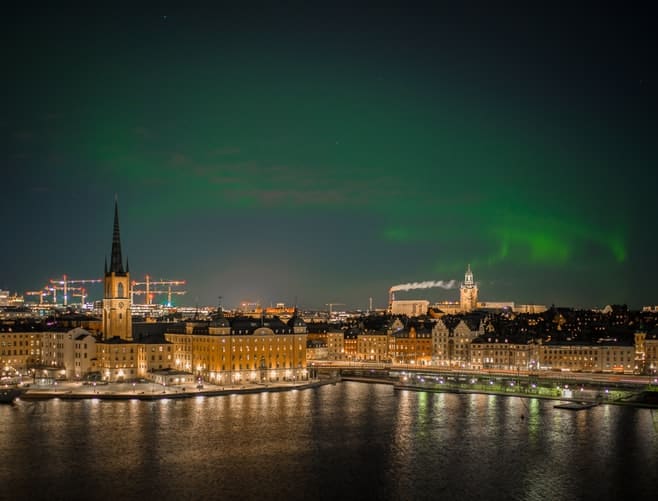
Locals here suggests that the tourists head over to the popular Parkgata street for a more exclusive setting. What’s even more interesting is that the Northern Lights are visible in different Norwegian cities. Disregard the hundreds of miles of distance between them.
The lowest cloud coverages of Abisko, Sweden made it one of the best places for an aurora experience.
Just the thought of the Northern Lights would be enough to take you to the Swedish Lapland. Fair enough, the country’s Abisko and Aurora Sky Station made it to the ranks of the most panoramic place to go to for the view. It promises a 100% success rate per 3-5 days of stay.
Fairbanks, Alaska is your go-to for the most unique Northern Lights experience.
The city sits conveniently just below the arctic circle as well as the nearby national parks. While it is among the cream of the crop aurora cities, there is no single best time of the year to see the aurora in Fairbanks. Still, it is worth considering that the days from November to January are much shorter than in summer.
Some North American Inuit Tribes refer to the lights as ‘Aqsarniit’ meaning ‘Football Players.’
The story behind the weird name is that the Inuits believe that the lights are spirits of dead people who are playing football. What’s more, is that they have a walrus head as their ball.
The other side of the Inuit tribe thinks that the Northern Lights represent spirits of the dead animals.
Narrowing down to those that they hunted for survival, a few of them are deer, salmons, seals and beluga whales.
Swedish legends view the Northern Lights as good luck and bearer of good news.
It is mostly because of the high level of tourism that its location brings in association with the Arctic Circle. Some regions refer to the aurora as a gift from the Northern gods. Meanwhile, fishing communities believe that the lights are a guarantor of the year’s hopeful fishing season.
The Baltic legends of the Northern Lights sound more like a party.
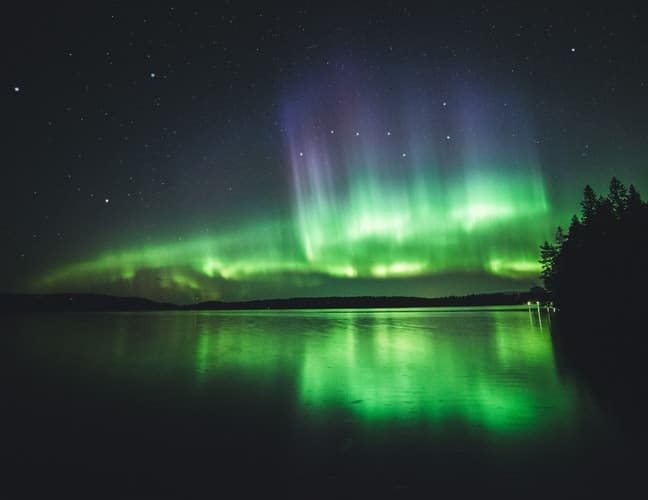
Estonian culture assumed that the lights that illuminate the skies are actually horse-drawn carriages bringing celestial guests to a blissful wedding.
Sadly for Italy and France, the Northern Lights mean a bad omen.
Residents of the two cities thought that the aurora proclaims the fury of anything from death to war to a plague. It started when the skies displayed red lights in Scotland and England just a few weeks shy of the French Revolution. Later on, it was considered as the sign of an impending conflict in their neighboring Gallic state.
Japanese cultural beliefs state that a child born under the aurora would be endowed with good looks, intelligence, and prosperity.
This Aurora fascination is possibly the reason for the timely increased number of visitors in Asian countries like Japan, Malaysia, and Singapore.
The Northern Lights Show during the 1859 great geomagnetic storms is the most spectacular of all.
Yes, the sight was magical back then on August 28 and September 2. However, anything similar would have brought modern civilization some serious damages if it was to happen today.
Spectacles like that of the Northern Lights are not exclusive to the planet Earth.
They also take place in spots everywhere in the solar system like in the planets Mars, Uranus, Neptune, Saturn, and Jupiter. Though the visuals are almost the same as what you could see on Earth, different substances make up these foreign lights.
These planets witness much brighter and ultraviolet lights due to their hydrogen composition.
Planet Venus also demonstrated a similar aurora phenomenon despite its non-magnetic field.
Scientists claim that what caused the Northern Lights-like show in Venus was the interactions of the planet’s ionosphere and the solar winds.
Several well-renowned people presented their own explanations about the Northern Lights.
A few of them are Aristotle, Descartes, Seneca, and Benjamin Franklin. They asserted that the lights came from the concentration of electrical charges in polar regions. All the moisture and snow in the said areas are considered to be intensifiers of the charges’ concentration.
Was this page helpful?
Our commitment to delivering trustworthy and engaging content is at the heart of what we do. Each fact on our site is contributed by real users like you, bringing a wealth of diverse insights and information. To ensure the highest standards of accuracy and reliability, our dedicated editors meticulously review each submission. This process guarantees that the facts we share are not only fascinating but also credible. Trust in our commitment to quality and authenticity as you explore and learn with us.
